
November 2023 Returns and Asset Performance
December 1, 2023
December 2023 Returns and Asset Performance
January 1, 2024S&P 500 Earnings Forecasts - 4Q.2023
Prelude to Earnings Season
The S&P 500 index saw year-on-year earnings growth for 4.8% in the third quarter. It’s now time to consolidate net income forecasts by company for the fourth quarter to see earnings growth estimates for the large-cap index and its eleven sectors.
Market Context
Return Profile
Prices and returns for the S&P 500 Index are profiled at right. In the last 30 days, the benchmark index (+8.6%) had its best month of the year. Since the end of the third quarter, the benchmark index increased 8 out of 10 weeks. And year-to-date (YTD) performance (+21.4%) has been impressive, even though market breadth has been weak and the median stock is up only 3.4%.
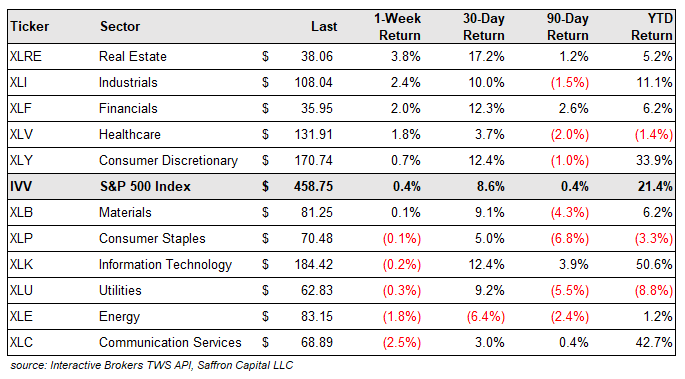
Sector Rankings
Relative return ranking by sector are presented at right. Each day, returns are calculated for each sector over a rolling time period and ranked. Th table confirms strong persistence in recent returns for Real Estate. Financial, Industrial, and Technology shares. All have benefited from falling interest rates since the end of October. In contrast, the Energy, Utilities, Health Care and Communication Service sectors have been persistently weak.
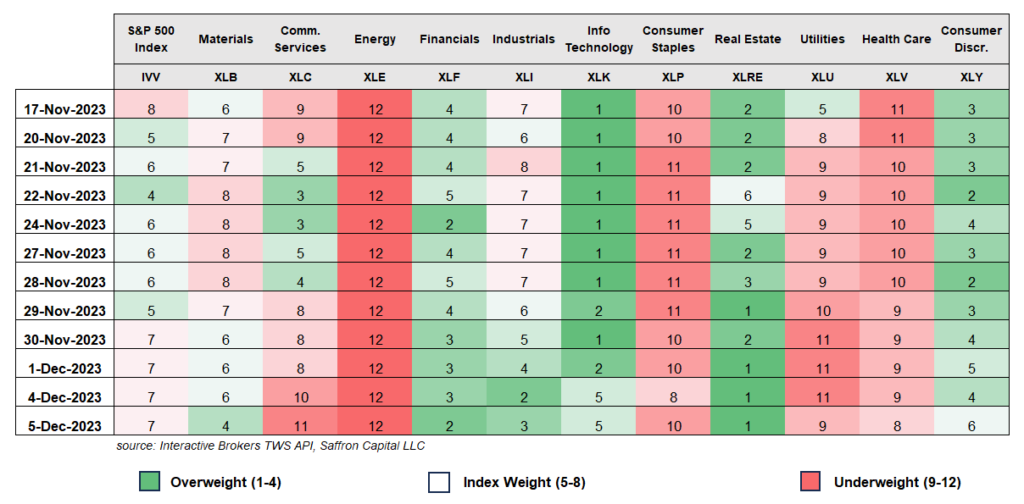
Market Risk Regimes
Each day, we confront he question “Is this a safe market to invest into? Our objective answer depends on a learning model to classify the market risk regime into 3 categories: Risk-Off, Risk-Neutral, and Risk-On. The learning model uses a small number of variables on market conditions. The risk regime categories are then used to define the level of market participation as follow:
- Risk-Off: 0% of funds invested in the index (100% invested in low-risk bonds or cash).
- Risk-Neutral: 50% of funds invested in the index (50% invested in low-risk bonds or cash).
- Risk-On: 100% of funds invested in the index (0% invested in low risk bonds or cash).
The plot below shows the current risk regime and all risk-off events flagged by the model in 2023. The current risk regime is risk-on, which has favored being 100% invested in risky assets, including the S&P 500 index and select sectors. The current risk-on status was preceded by limited market activity and participation from early August through early November. Returns during this period were elusive. However, capital preservation was also maximized during the risk-off events, limiting exposure to market drawdowns.
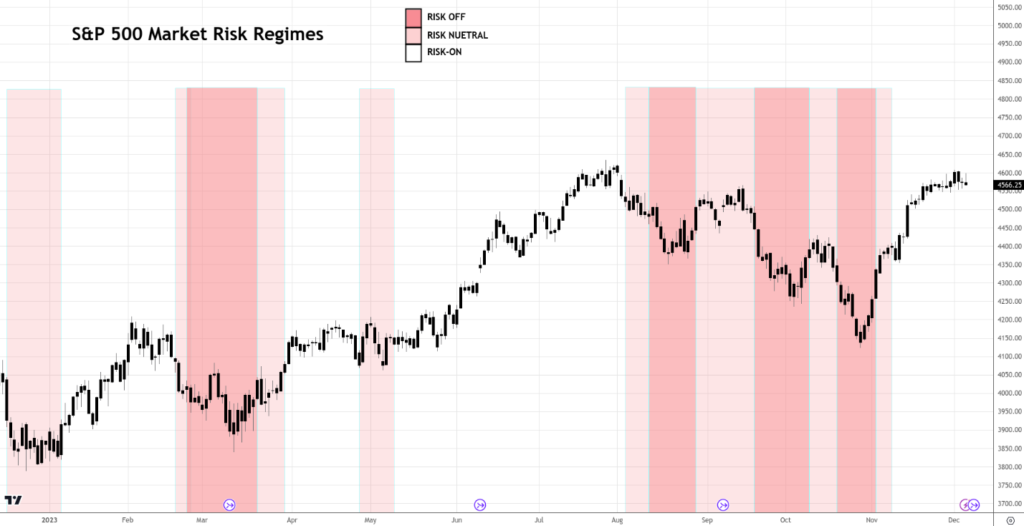
Projected Earnings 4Q.2023
Company Earnings Data
Companies provide net income estimates or earnings-per-share (EPS) guidance before the formal release of actual quarterly results. To date, 21% of the S&P 500 index companies have issued EPS guidance for 4Q.2023, or 106 of 503 companies. According to FactSet, 69 companies have issued negative EPS estimates versus prior estimates, and 38 companies have issued positive EPS guidance. The percentage of companies issuing negative EPS guidance is 64%, which is above the 5 year average of 59% and above the 10-year average of 63%.
Analyst consensus estimates for net income and EPS are available for all index constituents. At this point, analysts are projecting consolidated year-on-year earnings growth of 3.0% for the S&P 500 index, down from 8.0% at the start of the quarter. Its not clear what drives the consensus update, but clearly analysts share a strong bias toward economic contraction, contrary to the recent surge in GDP results. The contraction in projected earnings also implies that current valuations (P/E NTM) are being stretched by a combination of rising prices and falling earnings.
Earnings by Sector
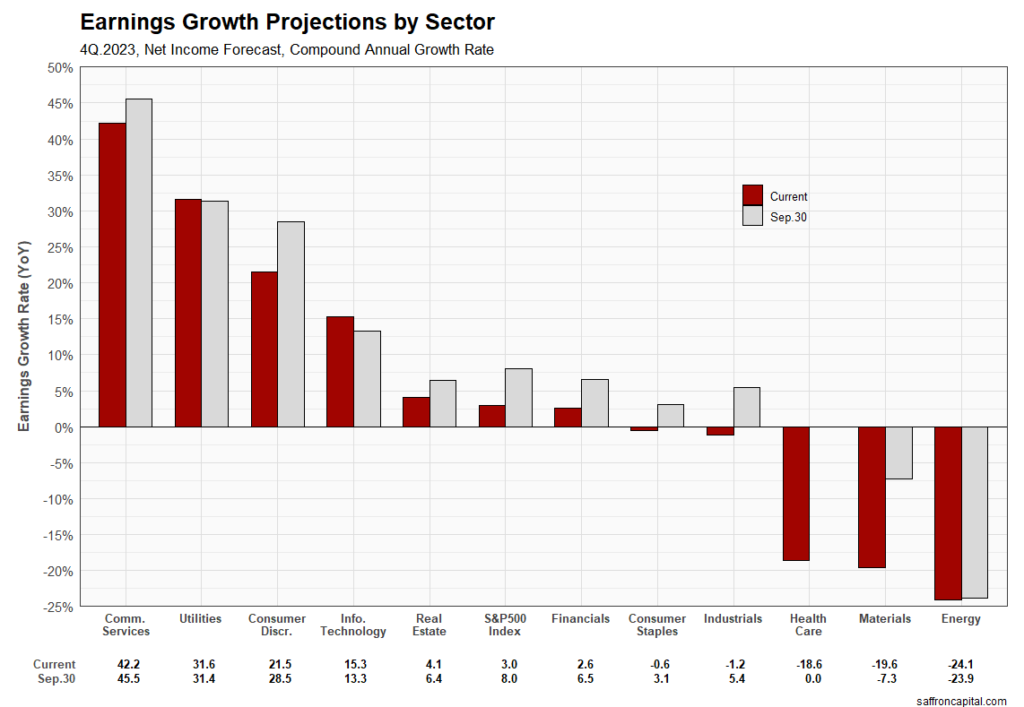
The sectors with the highest estimated earnings growth include Communication Services (+42.2%), Utilities (+31.6%), and Consumer Discretionary (+21.5%) shares. Laggards include Energy (-24.1%), Material (-19.6%) and Health Care (-18.6%).
The fourth quarter consolidated estimate for the S&P 500 index is below the realized results for the third quarter (+4.8%) and above the expected earnings growth for all of 2023 (+0.8%).
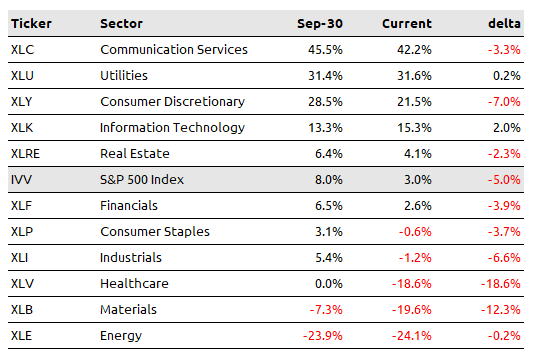
Sector Earnings vs Return Momentum
The next chart compares the absolute change in earnings growth estimates since Sep-30 versus return momentum by sector. Normally, we see high return momentum in sectors with positive changes in earnings outlooks. This again the case. For example interest rate sensitive sectors – such as Real Estate (XLRE), Financials (XLF), and Technology (XLK) – have seen earnings estimates increase as rates have fallen recently and return momentum versus index has been positive. Meanwhile, Communication Services (XLC), Consumer Staples (XLP), and Utilities have seen positive earnings changes, but these shares have low return momentum on a relative basis. Given the risk-on risk regime, our model portfolio owns the S&P 500 index plus the overweight sectors profiled below.
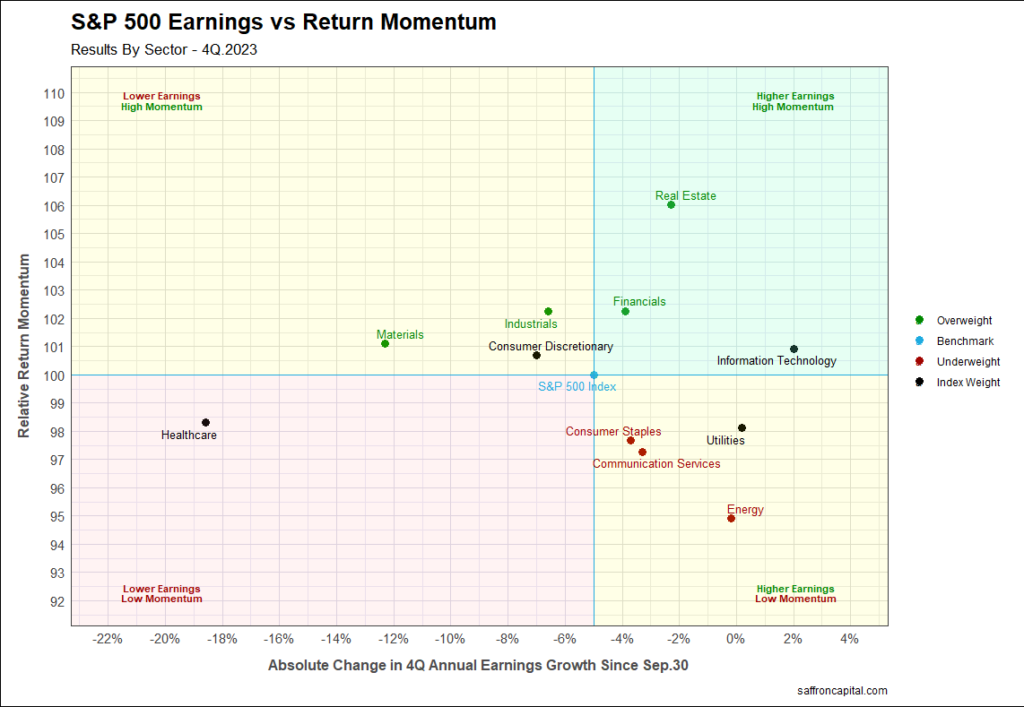
Using Earnings Estimates to Assess Value
Next, we extend sectors earnings date to generate traditional value metrics to assess the relative value of the different market sectors. For example, the Price/Earnings (P/E) ratio uses earnings forecasts for for the next twelve months (NTM) to compare sector portfolios.
The table at right lists the P/E NTM ratio for each sector. Current values are compared to the 5- and 10-year averages. You quickly see that the index is being pulled higher by 3 sectors, while trading at a premium to 8 sectors.
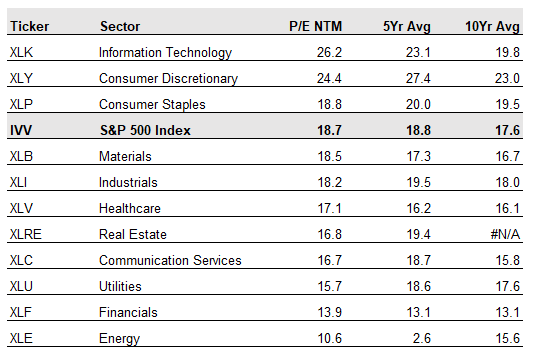
The next chart compares P/E ratios by sector to relative return momentum by sector. The chart clarifies whch sectors to overweight given a combination of low value and high return momentum. Real estate (XLRE), Financials (XLF), Industrials (XLI), and Materials (XLB) are all favored. Meanwhile, Technology (XLK) and Consumer Discretionary (XLY) shares are deemed as having very high value with only modest return strength versus index. Overall, the scatter diagram has a negative slope as expected.
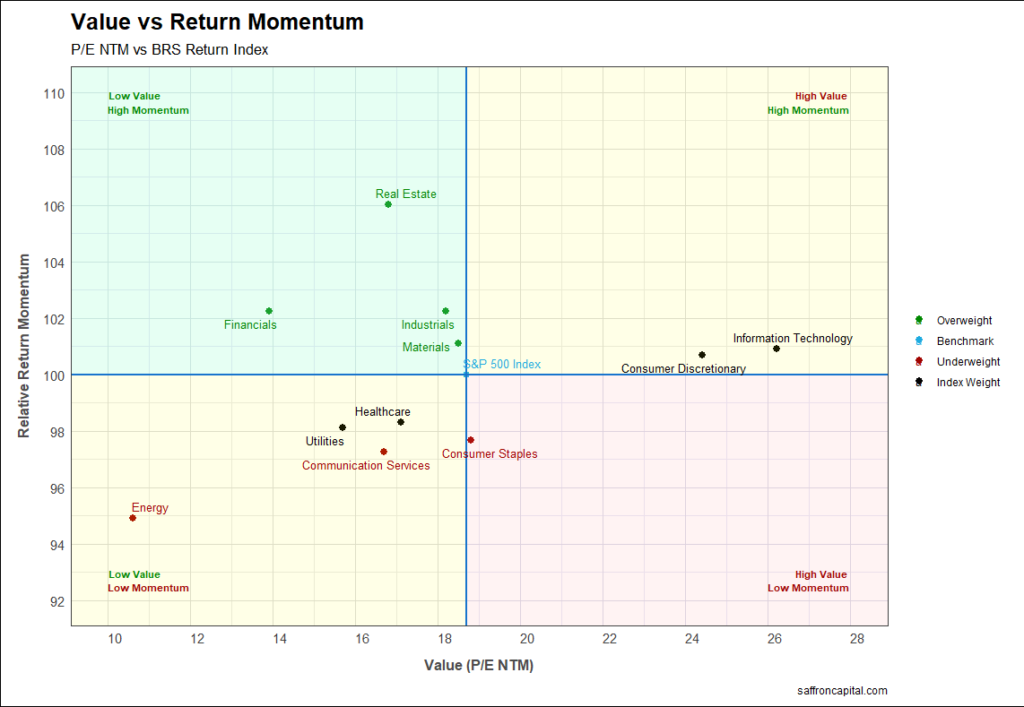
See the Signals
Contact us if you have questions about this report or how our model portfolios can help your investment performance. Looking for low cost index exposures with real-time risk management for capital preservation? Contact us here.
Important Notice
Saffron Capital LLC provides capital market research and insight reporting for informational and educational purposes only. The report does not constitute a solicitation to to buy or to sell any securities. We only provide investment advice to people or entities subject to an advisory agreement and a client-approved investment plan.
Any opinion about future events (such as market and economic conditions, company performance, security returns or valuations) are forward-looking statements. Forward-looking statements, by definition, involve risk or uncertainties and do not reflect actual knowledge about the future. Forward projects are valid inputs in any planning or investment process. However, they are not a guarantee of future returns or performance.




